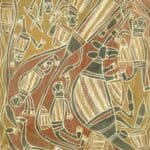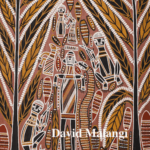Dawidi Aboriginal Art
Dawidi Birritjama was an aboriginal artist is best known for his depictions of the Wagilak sister’s creation story. He was the main custodian of this important story and this story is the main subject in his Paintings. Best known for his paintings on Bark Dawidi did also paint and carve some Mokoy sculptures.
If you have an artwork by Dawidi that you would like to know the value of or sell then please contact me. If you send me an email with an attached image and the dimensions I will get back to you.



Dawidi Early Years
Dawidi Birritjama was born on Milingimbi island around 1921. He belonged to the Galwanuk Clan and spoke Liyagalawumirr language. He was a toddle when the Methodist built a Mission on the Milingimbi island in 1923. This was a period of strong cultural change. Many aboriginals had to balance between keeping the mission pastor and traditional elders appeased. As a young man, Dawidi worked for the mission farm and around the community constructing fences. At the same time, he was being initiated into traditional life. He gained traditional ceremonial knowledge and learned to paint by watching his father’s brother.The Custodian
In 1956 in his mid 30’s Dawidi upon the death of his father’s brother became the traditional leader of the Liyagalawumirr clan. Dawidi was now the main custodian of the Wägilak sister’s ceremonial cycle. Not being an elder Djawa and Mungunu mentored Dawidi further into custom. Being the custodian of such an important ceremony was a huge traditional responsibility. By the early 1960s, Dawidi was able to assume his responsibilities in full. He became the primary authority in recording the Wägilak sisters in artworks. In 1961 Alan Fidock, a lay missionary and teacher arrived at Milingimbi. Fidock strongly supported the production and sale of traditional artworks. Fidock also documented Dawidi taking part in a Wurrpan (emu) ceremony with Binyinyuwuy at Milingimbi. When European collector Karel Kupka visited Milingimbi, Dawidi became his close confidant. Dawidi sold many artworks to Karel who in turn sold these artworks to institutions including many in Europe. When in 1965 Karel published a book called the Dawn of Art it features heavily in Dawidis artworks Dawidi painted at Maningrida on the mainland and at home in Milingimbi until his death in 1970. The artworks of Dawidi and Djawa were in an exhibit in 1997 called The painters of the Wagilag sisters story at the National Gallery of Australia.Wägilak Sisters
The story of the Wägilak sisters is the equal of Genisis for the people of Arnhem Land belonging to the dua Moiety. The legendary sisters arrived in Yirrkala and followed the morning star from East to West. As they traveled they bought the plants and animals and sacred sites into existence. They plunged their magic yamsticks into the earth in many places causing waterholes. The scene most often painted by Dawidi is when the sisters carrying their babies meet Julunggul the rainbow serpent. The sisters Inadvertently profane the rainbow serpents waterhole. Julunggul encircles the sisters and their children and swallows them. Julunggul realizing he has eaten people of his own moiety then makes amends revealing secret and powerful rituals. It is these rituals and ceremonies that are still practiced by the men of the dua moiety. In Dawidi art, if you see people surrounded by a snake it is the Wagilak sisters and the rainbow serpent. In fact, almost all of Dawidi’s art refers to this core story. Sometimes the iconography is not clear unless you are familiar with the full story. Every yam basket, fish, lizard, or rainbow Dawidi paints is a part of the same creation story.
Other Aboriginal Art and Artists
All images in this article are for educational purposes only.
This site may contain copyrighted material the use of which was not specified by the copyright owner.
Dawidi artwork Images
The following images are of the Artworks of Dawidi. It is not a complete list of his works. They do however give a good idea of the style and above all the variety of this Aboriginal Artist.

If this post has been informative please take the time and make the effort to share it on social media. By clicking any of the share buttons below you create a link from your social site to this article. Links are what google uses to calculate what information on the web is useful. By sharing this article you are letting google know you found my article / images of some value. Thanks!


















